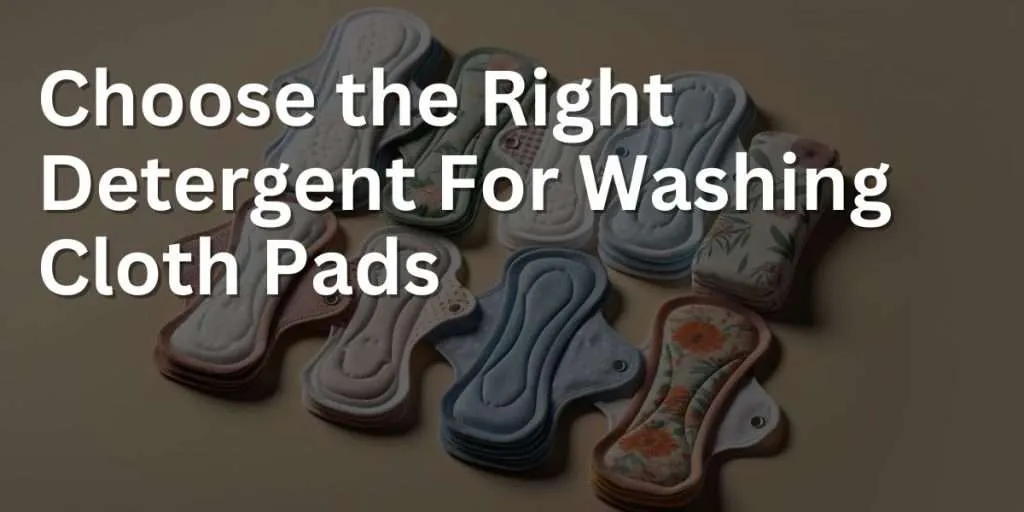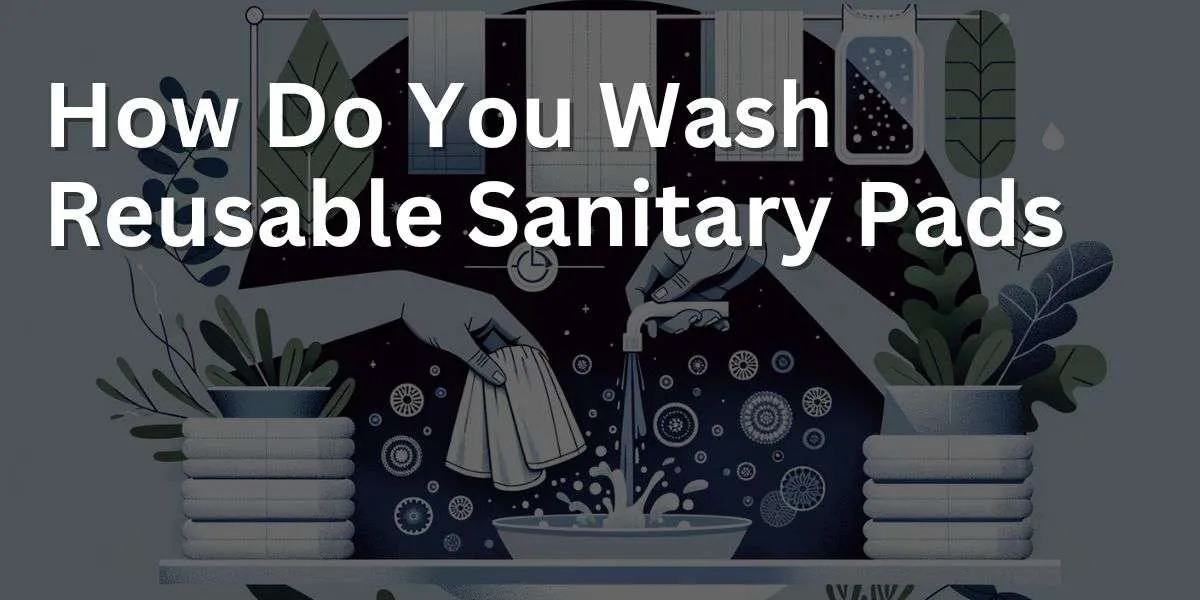You’ve made the eco-friendly switch to reusable sanitary pads, but now you’re wondering how to keep them clean and hygienic. Don’t worry, you’re about to master the simple steps to wash your cloth pads effectively.
From choosing the right detergent to the best drying techniques, we’ll guide you through maintaining your pads so they remain as good as new.
Ready to tackle pad care like a pro? Let’s dive into the essentials of washing your reusable menstrual pads.
Key Takeaways: Washing Reusable Sanitary Pads
- Rinse pads immediately after use. This prevents staining and removes a significant amount of menstrual blood.
- Soak in cold water if needed. Soaking can help to further loosen any remaining blood before washing adding bleach alternatives like hydrogen peroxide or white vinegar for disinfection and stain prevention
- Use a gentle, non-fragrance detergent. Harsh chemicals can break down the fabric and irritate the skin. Choose a gentle, enzyme-free detergent for preserving fabric integrity and enhancing stain removal.
- Wash in a washing machine or by hand. Either method is effective, but ensure they are washed thoroughly.
- Avoid using fabric softeners. These can reduce the absorbency of the pads.
- Dry pads completely before reuse. This can be done in a dryer or air-dried to prevent any mildew growth.
- Store pads in a clean, dry place. Proper storage ensures hygiene and extends the lifespan of the pads.
- Check pads regularly for wear and tear. Regular inspection helps to maintain their effectiveness and hygiene.
Gather Your Materials For Washing Sanitary Pads
Before you begin, ensure you’ve got all five essential materials ready for effectively washing your reusable sanitary pads.
Choose a gentle, enzyme-free detergent to preserve the fabric’s integrity and enhance stain removal.
Cold water can be less effective at eliminating bacteria; hence, opt for warm water, but never hot, as high temperatures can set stains and degrade the material.
Assemble a soft-bristled brush for tackling stubborn spots without damaging the pads.
Have a container for soaking pads prior to washing, ensuring you’re not only maintaining hygiene but also practicing sustainable menstrual management.
Pre-Rinse and Soak Your Reusable Pads
To start, rinse your reusable pads under cold water to remove initial discharge and prevent stains from setting in. Cold water is crucial for effective stain removal, as higher temperatures can cause proteins in the discharge to bond with the fabric.
After the pre-rinse, soak your pads in cold water, too. You may add bleach alternatives like hydrogen peroxide or white vinegar to the soaking solution to aid in disinfection and further prevent staining without the environmental impact of chlorine bleach.
Frequency recommendations for the pre-rinse and soak vary, but doing this shortly after use is ideal. This routine not only contributes to the longevity of your pads but also aligns with eco-friendly practices by reducing the need for harsh chemicals during the washing process.

Choose the Right Detergent For Washing Cloth Pads
When selecting a detergent for your cloth pads, opt for a gentle, fragrance-free variety to preserve the material and avoid skin irritation. Your choice should take into account fabric sensitivity and allergy considerations to ensure the best care for both your skin and the pads. Here are some criteria to guide you:
- Fabric Sensitivity: Choose a hypoallergenic detergent to prevent damaging the cloth fibers.
- Allergy Considerations: Avoid irritants by selecting a detergent that’s free of dyes and perfumes.
- Environmental Impact: Consider eco-friendly detergents that minimize harm to the ecosystem.
- Cost Efficiency: Balance effectiveness with affordability, but don’t compromise on quality.
Beware of detergent residue, which can reduce the absorbency of your pads, and always follow product instructions for the optimal wash.
Hand Washing Technique For Cloth Pads
Once you’ve chosen a suitable detergent, you’ll need to master the hand washing technique to keep your cloth pads clean and functional.
For effective stain removal, pre-soak your pads in cold water, as hot water can set stains. After soaking, use a designated scrubbing tool—such as a soft brush or a cloth—to gently work the detergent into the fabric. Avoid fabric softeners, as they can reduce absorbency over time.
Adjust the water temperature to lukewarm for the main cleaning; too hot can damage the pads, too cold won’t clean as effectively. Perform thorough rinse cycles until the water runs clear, ensuring all soap residue is removed.
Mastery in hand washing your cloth pads will extend their lifespan and maintain their hygiene.
Machine Washing Steps For Reusable Menstrual Pads
If you’re looking to speed up the cleaning process, tossing your pre-soaked reusable menstrual pads into the washing machine is an effective alternative.
Here’s how to ensure they come out clean and well-maintained:
- Pad Separation: Separate your pads from other laundry to prevent the transfer of bodily fluids and provide a thorough wash.
- Stain Treatment: Address stains before the wash with a natural stain remover to maintain the pad’s appearance.
- Cycle Selection: Opt for a gentle or regular cycle to balance cleaning power with fabric care.
- Water Temperature: Use cold water to prevent setting stains, and avoid hot water which can shrink or warp the fabric.
Drying and Sunning Reusable Menstrual Pads
After washing your reusable menstrual pads, it’s essential to dry them properly to maintain their absorbency and shape. Lay them flat on drying racks to ensure even air circulation. This method preserves pad longevity by preventing fabric warping. If you’re sunning your pads, UV sterilization can naturally disinfect the fabric.
Be mindful of fabric fading with prolonged exposure to direct sunlight. Consider weather considerations; on humid or rainy days, opt for indoor drying to prevent mildew. Here’s a table summarizing key points:
| Factor | Benefit | Caution |
|---|---|---|
| UV Sterilization | Natural disinfection | May cause fading |
| Drying Racks | Promotes air circulation | Use flat surfaces |
| Pad Longevity | Maintains shape and absorbency | Avoid high heat |
| Fabric Fading | Sun can refresh fabric | Limit sun exposure |
| Weather Considerations | Adjust drying method accordingly | Protect pads from rain |
Storage and Maintenance of Cloth Sanitary Pads
Properly storing your reusable sanitary pads ensures they’re ready for your next cycle and extends their lifespan. To maintain their condition, it’s essential to adhere to optimal fabric selection and hygiene practices. Here are some key considerations:
- Choose breathable fabrics for storage to prevent mildew and maintain fabric integrity.
- Implement rotation tips, allowing each pad ample rest between uses to avoid fabric fatigue.
- Master stain removal techniques to tackle any discoloration promptly, preserving the aesthetic of your pads.
- Learn basic repair methods to address wear and tear, ensuring your pads remain functional for as long as possible.
Frequently Asked Questions About Washing Reusable Sanitary Pads
Can I Use Fabric Softener on My Reusable Sanitary Pads?
You shouldn’t use fabric softener on your pads; it affects absorption. Opt for alternatives that maintain material care. Avoid scented products and choose appropriate drying techniques to extend your pads’ lifespan and efficacy.
How Can I Remove Stubborn Stains That Don’t Come Out During the Regular Washing Process?
To tackle stubborn stains, first apply a stain pre-treatment. Then use natural soakers or enzyme cleaners, followed by a cold water rinse. Sun bleaching can also be effective for persistent spots.
Is It Safe to Wash Reusable Sanitary Pads With Other Clothes, or Should They Be Washed Separately?
You should wash your pads separately to avoid cross-contamination concerns. Choose a hypoallergenic detergent to minimize allergy risks and use a high washing temperature for optimal sanitary hygiene.
How Often Should I Replace My Reusable Sanitary Pads?
You should replace your pads when you notice material wear or decreased absorbency. Conduct an absorbency test; frequent usage shortens pad lifespan, considering environmental impact, aim for every 6 months to 2 years.
Can I Travel With Used Reusable Sanitary Pads, and if So, What Is the Best Way to Transport Them Hygienically?
You can travel with used pads by storing them in travel pouches with odor control. Use soaking solutions for hygiene, and consider discreet disposal options to maintain privacy and capitalize on environmental benefits.





